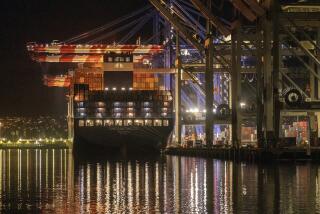90-Year-Old Newport Rich in History
- Share via
Friends once asked my wife and me if we’d like to have dinner at their home in Newport Beach. We were late because, though we easily found their street, we couldn’t find their address number--at least not in Newport Beach. It was in Costa Mesa. When we asked why they said they lived in Newport Beach, the wife shrugged: “Newport Beach just sounds so much better.”
It reminds me of those T-shirts sold by Virgin Megastore at Triangle Square in Costa Mesa, which erroneously implied the store was in Newport Beach. Store clerks said they thought the shirts would sell better that way.
Such is the aura of Newport Beach. The crown jewel of the Gold Coast. Playground of the rich. The tourists’ delight. And if you’re a Newport Beach resident, you might want to stick a lot of candles on your cake this coming week: Newport Beach is turning 90.
Incorporation was approved Aug. 12, 1906, (the vote was 42-12) but the papers were signed Sept. 1 that year, and it was Sept. 3 when the town was officially declared born with the first meeting of its Board of Trustees. It faced two main issues immediately: whiskey and drinking water. The area had been dry because the previous owner of all the land, James McFadden, was a notorious prohibitionist. Many of the fishermen thought a tavern or two would spice up the town. (They won when the board voted 3 to 2 in favor.)
McFadden had built a wharf about twice the width of the current city pier. He dreamed of turning the bay into a great shipping port. But competition from San Pedro ended those plans, much to the delight of many residents who considered Newport Beach more suited as the pleasure port it is today.
Modern Newport Beach ranks just a few notches below Beverly Hills as the most expensive real estate in California ($519,666 for the average 2,200 square-foot Newport Beach home, says Coldwell Banker). Which makes it all the more astonishing that McFadden sold off his lots at $70 an acre.
I asked Ellen K. Lee, a local historian who lived for many years in Newport Beach--and wrote her own book about the bay--what she considered its appeal.
“The geography,” she quickly answered. “Where could you find a more beautiful stretch of land than Newport Beach?”
In addition, she added, the railroad coming through soon after incorporation brought in a lot of the well-to-do from Los Angeles and Pasadena. They considered the Newport Peninsula, or one of the islands, the perfect place to park their yachts. The rich have been settling there ever since. And so have a lot of seasonal tourists.
How many tourists does it draw now each year? “It’s in the millions,” says Newport Beach Conference and Visitors Bureau director Rosalind Williams. Her office recently put out a two-paragraph blurb announcing its new visitors guide. In three days, it had generated nearly 1,000 telephone inquiries. Said Williams: “People are still very much interested in Newport Beach.”
That Clean-Cut Image: It’s not likely that William Grundy ever thought about living anywhere but Newport Beach. His father was the city’s first doctor (started the first hospital too) and Grundy graduated from high school there (Class of ‘41). For as long as anyone can remember, Grundy has been president of the Newport Beach Historical Society. And he’s an unabashed booster.
“When you drive up and down the coast and look at other beach towns, some of them are so crumby or so poorly developed,” he said. “But you go to Newport Beach, it’s a beautiful city from any place you enter.”
I joked with him that it’s a tiny bit exclusive. Yes, Grundy said, it’s expensive to buy in: “Some of us lucky enough to hold on to a home. Some places get passed on generation to generation.”
Grundy, who’s in the real estate business, remembers when sometime after World War II the city paid $25,000 for a study of what its future ought to be.
“This fellow came up with a plan that would have turned us into another Miami Beach, high-rises stretching all along the sand. We’re sure glad that idea never went anywhere.”
The Pitch: Here’s how the convention bureau pitches Newport Beach in its colorful new guide: “Our Mediterranean climate of balmy days and cool evenings provides a perfect year-round backdrop for a refreshing vacation, successful business conference or family outing.”
Now it’s passing out to potential clients a new book by Balboa artist Steve Simon called “Newport Beach: Celebrating 90 Years.” The Simon prints depicted are not only brilliant, they tell a history of the city. The cover is a piece he calls “Sunday Sail.” Mayor John Hedges said he was so impressed when he saw one of the originals that he bought a print on the spot.
Island Christmas: Many of us in the county rarely get to Newport Beach. I can’t afford its best golf courses, few of its good restaurants fit a family budget, and other cities offer better hotel prices.
But let me suggest a good reason to visit there at least once a year: If you’ve never been to its evening Newport Harbor Christmas Boat Parade, you’re missing a great evening.
Mark it on your calendar. Go early, take blankets and a picnic basket and park yourselves on the narrow strip of sand around most of Balboa Island. The luxury yachts and their spectacular lights are not the only attraction. The waterfront residents of Balboa decorate their homes in magnificent style for the Christmas season, and a leisurely hourlong stroll around the island is enough alone to make you glad you added this to your list of things to do for the holidays.
Wrap-Up: I’ve written before about Ellen K. Lee, who lives now in Laguna Beach, and what she’s done to help preserve this county’s history. She’ll soon go into Hoag Memorial Hospital Presbyterian in Newport Beach for hip surgery and will be in recovery for several weeks.
Here’s a little of what Lee wrote about Newport Beach life at the turn of the century, just before incorporation:
“Small pioneer dwellings stood on stilts as protection against high tides. At the end of the wharf, in deep water, the largest oceangoing freight and passenger vessels could put in to unload and load their cargoes.
“Photographs reveal an oceanfront settlement with boardwalks across the sand, a few windmills, two wooden hotels, a curio store, board-and-batten houses, outhouses, a 2-room schoolhouse, and a corral and feed lot for horses, buggies and wagons. People from inland farms and towns thronged to Newport Beach every summer to fish from the wharf, to pitch tents and camp on the beach, to rent rowboats, and to swim in the ocean and bay.”
Sounds like the makings of a great city.
Jerry Hicks’ column appears Tuesday, Thursday and Saturday. Readers may reach Hicks by call-ing the Times Orange County Edition at (714) 966-7823 or by fax to (714) 966-7711, or e-mail tojerry.hicks@latimes.com
More to Read
Sign up for Essential California
The most important California stories and recommendations in your inbox every morning.
You may occasionally receive promotional content from the Los Angeles Times.










